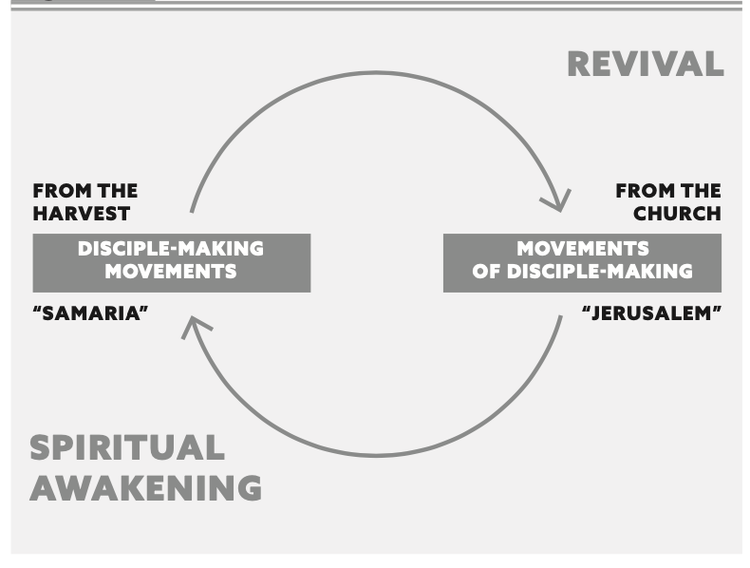The Starfish and The Spirit: The Church as a Missional Movement
We Must Reimagine…The Church as a Missional Movement
Over 50 years of the church growth movement has given us bigger churches but it has not given us a bigger Church. The Church in the West is by every measurable metric in trending decline. If we are to have a viable future we must tap into our inherent capacity to reimagine the church as a decentralized network of multiplying disciples, leaders, houses, hubs, and networks that fill a city or region with the fullness of Jesus.
Our driving question is usually, How can I grow my church? We’re pretty much obsessed with a singular expression of the church. Yet in the New Testament, we see microchurches in homes, in the cities, and in the regions working as one church, a movement with multiple leaders and elder teams, interdependently networked as a body. Their driving question was, How can we multiply the number of people entering and experiencing the kingdom, and the influence of the kingdom, regardless of who gets the credit or increase?
Imagine our cities being filled with the life of heaven here on earth. Imagine developing a missionary on every street and a microchurch in every neighborhood or network of relationships.
Several years ago I coined a term that became the name of a missional conference my friend Brad Brisco and I organized: Sentralized. The word emphasized the centralization of hub and the decentralization of households of God’s people sent into the various neighborhoods and marketplaces of our cities.
The church can be reimagined as a mission agency that exists to empower and equip people to live with a producing and co-owning ethos, living fully as missionaries where they live, work, learn, and play, making disciples and leading simple forms of church. In a Jesus movement, everyone follows and everyone leads. In a Jesus movement, every disciple is called to make disciples, find their calling, and own their mission fully.
What Makes a Movement, and How Do We Measure It?
The critical starting point of any faith movement is the flourishing and multiplying that happens when individuals become owners of the faith. We must begin with developing disciples, people who hear and obey Jesus in all of life. Then those disciples make other disciples. We must paint and pursue a vision of Discipling before churching. Disciples always become a church but churches in the traditional vein don’t always become disciples.
As people begin to multiply disciples, they become leaders, often without knowing it early on. As each disciple becomes one who makes one, who can make another, then all followers are invited to be leaders. In a Jesus movement, everyone follows and everyone leads. Therefore, disciple-making is the beginning of and the most potent form of leadership development in the starfish movement. Disciple-making movements catalyze leaders like crazy. If you pay attention to an epistle like Romans, the list of leaders popping out of the network of microchurches is amazing. Paul lists more than twenty-five leaders by name in chapter 16. When people focus on disciple-making, leadership will always follow. Discipleship is the tree. Leadership is the fruit.
The opposite is not always true. Churches that become obsessed with leadership pipelines that focus on skills, techniques, and specific roles—whether volunteers or church planters—but aren’t built on the foundation of disciple-making will find those pipelines spitting out the wrong sorts of leaders. In our book The Starfish and The Spirit four of the starfish we cover equip you to create a culture for multiplying discipling leaders. As we multiply disciples and leaders, we get teams. The teams own the mission of Jesus in a neighborhood or network, then become the core for a church.
There is a need for two different types of discipleship mobilization pathways. Two forms of disciple-making are required in post-Christian, postmodern America.Churches that discover both forms of mobilization will have the “best of both worlds,” revival in the church, and spiritual awakening among the lost. They can operate synergistically, like a flywheel. These two pathways are:
Disciple-Making Movements (DMM): a rapid, immediately viral, multiplicative, indigenous movement, creating new disciples from lostness four generations deep on multiple strands. The direction of mobilization is from the harvest toward the church. The focus is regeneration of the lost into disciple-makers.
Movement of Disciple-Making (MDM): a slower, eventually viral, multiplicative, indigenous movement, creating new disciples from believers in the church four generations deep on multiple strands. The direction of mobilization is from the church toward the harvest. The focus is catalyzation of believers into disciple-makers.
Churches can actually engage both at the same time, but will likely major in MDM, and then begin a DMM effort. These can run in tandem and even help amplify each other. We dig deeper into this in The Starfish and The Spirit, with examples of both pathways.
From Old Power to New Power
A small or medium sized congregation could be unleashed into a starfish movement with the right kind of leadership. Leadership is always an issue of power: Who has it and how it is used. In the starfish expression, the locus of power is spread throughout a network in many locations, leaders, and teams. What starts as one starfish will multiply to many, creating
a starfish network. The power doesn’t reside in one place but in multiple ways that operate like nodes throughout the network. The power and information move in multiple directions, depending on the usage and need within the network. The goal is to multiply and connect disciples, leaders, teams, churches, and networks in interdependent ways. Within the network, there are multiple points of power. Multiple leadership teams work interdependently with the goal of gospel saturation in a city, region, or country.
In the Harvard Business Review article “Understanding New Power,” authors Jeremy Heimans and Henry Timms make the following distinction between “old power,” what we call the spider, and “new power,” what we call starfish:
Old power works like a currency. It is held by few. Once gained, it is jealously guarded, and the powerful have a substantial store of it to spend. It is closed, inaccessible, and leader-driven. It downloads, and it captures. New power operates differently, like a current. It is made by many. It is open, participatory, and peer-driven. It uploads, and it distributes. Like water or electricity, it’s most forceful when it surges. The goal with new power is not to hoard it but to channel it.
Leaders who reimagine the church, with new power models and values, give their platform to others to develop and launch them out on mission. The focus shifts from developing your own leadership to multiplying and developing the influence of others, decentralizing the power and authority out to them while activating their gifts, their dreams, and their kingdom assignments.
By Lance Ford
Adapted from The Exponential Series book, The Starfish and The Spirit by Lance Ford, Rob Wegner, and Alan Hirsch



